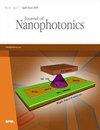Ge2Sb2Te5 patch embedded ring resonator for optical switching
IF 1.1
4区 物理与天体物理
Q4 NANOSCIENCE & NANOTECHNOLOGY
引用次数: 0
Abstract
A Ge2Sb2Te5 (GST)-based microring resonator is designed and analyzed for optical switching-based applications. First, the optical properties of GST material having thicknesses of 130 to 230 nm on two commonly used substrates, i.e., silicon (Si) and silicon dioxide (SiO2), are investigated in detail. The phase-change property of GST plays an important role in tuning the resonant wavelength, absorption, and transmission loss in the ring resonator as its crystalline state has a higher refractive index (RI) compared with the amorphous state. Due to the phase-change property of the GST material, the effective RI of the waveguide core changes. A patch of GST is embedded on a ring resonator to optimize the response of light coupled in the ring and straight waveguide, that is tunable between its amorphous phase (a-GST) and crystalline (c-GST) phase. The difference in refractive indices between the two states of a phase-change material (PCM) renders it an optimal choice for the optical active devices used in light modulation and switching applications. The GST is employed as an active material in the proposed structure as it is significantly stable and results in reduced insertion loss (IL) compared with other PCMs. In the proposed design of the ring resonator, the finite-difference time-domain simulation demonstrates high extinction ratios of 16.05 and 20.50 dB at the THROUGH and DROP ports, respectively. Moreover, the low insertion losses (IL) of 0.33 dB at the THROUGH port in crystalline phase and 0.8 dB at the DROP port in amorphous phase, have been observed. The Q-factor of the ring resonator without a GST patch is 5.18×105, whereas with a GST patch, it is 5.13×105 and 1.28×105 in the amorphous and crystalline phases, respectively.用于光开关的 Ge2Sb2Te5 贴片嵌入式环形谐振器
本文设计并分析了一种基于 Ge2Sb2Te5(GST)的微菱形谐振器,用于基于光学开关的应用。首先,详细研究了两种常用基底(即硅(Si)和二氧化硅(SiO2))上厚度为 130 至 230 nm 的 GST 材料的光学特性。GST 的相变特性在调节环形谐振器的谐振波长、吸收和传输损耗方面起着重要作用,因为与无定形状态相比,其晶体状态具有更高的折射率 (RI)。由于 GST 材料的相变特性,波导芯的有效 RI 发生了变化。在环形谐振器上嵌入一片 GST,以优化环形波导和直波导中耦合光的响应,该波导可在非晶相(a-GST)和晶体相(c-GST)之间进行调谐。相变材料(PCM)两种状态之间的折射率差异使其成为光调制和开关应用中光学有源器件的最佳选择。与其他 PCM 相比,GST 具有明显的稳定性,并能降低插入损耗(IL),因此在拟议结构中被用作有源材料。在环形谐振器的拟议设计中,有限差分时域仿真显示,在 THROUGH 端口和 DROP 端口的消光比分别高达 16.05 和 20.50 dB。此外,晶体相 THROUGH 端口和非晶相 DROP 端口的插入损耗(IL)分别为 0.33 dB 和 0.8 dB。无 GST 贴片的环形谐振器的 Q 因子为 5.18×105,而有 GST 贴片的非晶相和晶体相谐振器的 Q 因子分别为 5.13×105 和 1.28×105。
本文章由计算机程序翻译,如有差异,请以英文原文为准。
求助全文
约1分钟内获得全文
求助全文
来源期刊

Journal of Nanophotonics
工程技术-光学
CiteScore
2.60
自引率
6.70%
发文量
42
审稿时长
3 months
期刊介绍:
The Journal of Nanophotonics publishes peer-reviewed papers focusing on the fabrication and application of nanostructures that facilitate the generation, propagation, manipulation, and detection of light from the infrared to the ultraviolet regimes.
 求助内容:
求助内容: 应助结果提醒方式:
应助结果提醒方式:


